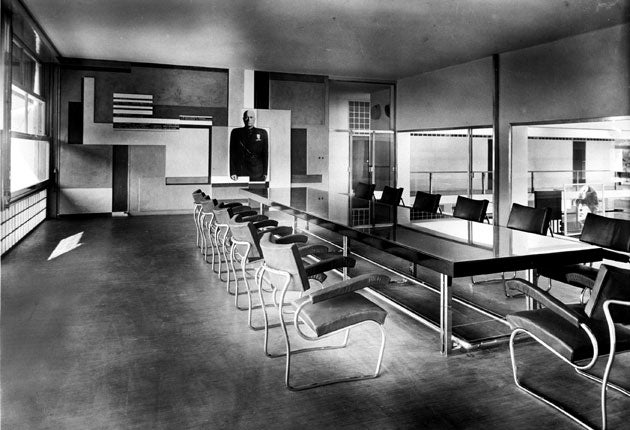Framing Modernism, Estorick Collection, London
Modernism came relatively late to Italy, where photography and architecture became constant companions

No one knows who took the photograph of Ignazio Gardella's tuberculosis dispensary in the Piedmontese town of Alessandria, although the drama of the shot – clouds scudding above the building's gridded façade, the picture's composition cunningly off-balance – suggests someone who knew what he was doing.
The photographer is clearly in love with Gardella's rationalism, his symphony of right angles and planes; in one sense, the image – included in the Estorick Collection's show Framing Modernism – sets out to replicate them. But in another, the anonymous picture does more than merely record. The black-and-white photograph shows Gardella's building as monochrome, no colour distracting from its geometric perfection. Actually, the dispensary's open-work screen was of local umber brick, its walls rendered in yellow plaster. Whoever shot the building wasn't just matching Gardella. In terms of purity, he was outdoing him.
Italy in the 1920s was a place in love with modernity, and with Modernism. The relatively late arrival in the country of Modernist architecture – Gardella's airy design signs up wholeheartedly to the Bauhaus creed of Licht, Luft und Sonne (light, air and sun) – coincided with a revolution in photography. Smaller, quicker cameras allowed their users to interact with buildings in a way that would have been impossible a decade before. By the late 1920s, the affection of photography for architecture had blossomed into love. Buildings joined picnics and wedding parties as a subject for studio photographers and amateurs alike, and image-led architectural magazines opened more or less daily. For the first time in Italian history, style and taste were disseminated principally by photograph.
A question raised by Framing Modernism is the extent to which the aesthetics of photography – the democratic way of seeing afforded by cheaper, more portable cameras – influenced those of the buildings it set out to record. The case of Gardella's dispensary is intriguing. Just as Johann Joachim Winckelmann's mistaken belief that antique marble sculpture had all been white wrote the rules of Neoclassicism – for a century, colour would be seen as a vulgar distraction from purity of form – so photography's monochrome palette left viewers with the impression that Modernism was colourless. To some extent, that belief still holds: witness the squeals of mingled joy and horror that greet the shocking pink structures of the Mexican architect Luis Barragan today. But it is interesting to think that the white-and-grey palette of even so great an architect as Pier Luigi Nervi might have been based, at least in part, on the technical limitations of another medium.
The second part of the show deals with Italian architecture after the Second World War, when the link between camera and building is clear to see. The dramatic underlighting and heroic ordinariness of an anonymous shot of the Cinema Altino in Padua, designed by Quirino de Giorgio and opened in 1951, echoes the look of the Neorealist films playing inside. So, too, does the building's style. Still camera and movie camera are clearly in league, with architecture as their subordinate. Sometimes, the ganging-up of lens and building takes a different form. In Vittorio de Sica's 1953 film, Stazione Termini, the titular Terminal Station's concrete ticket hall acted the movie's stars – Jennifer Jones and Montgomery Clift – off the screen.
But it is the first part of this show that really intrigues, with its suggestion of the newness not just of Italian architecture and photography, but of the compact between them. Here is an exuberant world, exuberantly seen – as you wander through the Estorick's galleries, you find yourself wishing you'd been there. And then dark passages appear among the white.
The sign on that elegant pavilion reads, on inspection, Casa del Fascio (Fascist House); the pavilion is in Eritrea, Italy's brutalised colony. The seaside colonia for workers' children near Pisa – so handsome, so idealistic! – is named for Rosa Maltoni Mussolini, Il Duce's mother. That chic structure in Milan by Ernesto Rogers, cousin of Richard, is a memorial to Italy's deported Jews, among them Rogers' architectural partner, Gian Luigi Banfi, who perished, at 35, in Mauthausen. So, too, did Giuseppe Pagano, Jew, architect, pilot and editor of the hugely influential Casabella magazine. Pagano's vertiginous shot of the 1940 stadium in Florence is full of a flyer's excitement at the promise of the new and Modern; a promise which – like Pagano himself – would soon fall, tragically, to earth.
London N1 (020-7704 9522) to 21 Jun
Join our commenting forum
Join thought-provoking conversations, follow other Independent readers and see their replies
Comments